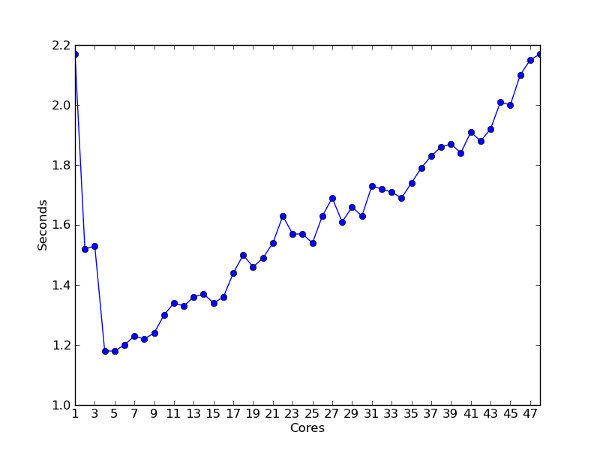2012 0011 0024
There are a number of ways to go about building a modern development
environment for scientific computing and computer vision in python.
If you’re used to developing on bleeding-edge, however, the latest
debian stable makes it a chore to get started with the latest and
greatest. It ships with python2.6 instead of 2.7, and opencv
is notoriously out of date in a number of distributions, debian
included. I typically use Arch, but the server-class machines I have
access to were running debian, so I had to bootstrap my setup into
this environment.
Challenge accepted.
Thankfully, pythonbrew (or pythonz) comes to the rescue by making it easy to handle multiple pythons for a single account (without having to install them system-wide) as well as providing wrappers around virtualenv. However, not everything is rosy. The python you choose has to be built with shared libraries if you want to install opencv later:
pythonbrew install --configure="--enable-shared" 2.7.3After this, you can bootstrap a virtualenv as usual
pythonbrew venv init
pythonbrew venv create debian
pythonbrew venv use debianand install any requisite stuff you might need (minimum numpy/scipy)
pip install numpy
pip install scipy
pip install pymorph
pip install matplotlib
pip install distutilsUnfortunately, there’s no such pip package for opencv. Thankfully,
the debian installation guide isn’t too far out of date, and many
of the listed packages to apt-get are still relevant.
wget http://downloads.sourceforge.net/project/opencvlibrary/opencv-unix/2.4.3/OpenCV-2.4.3.tar.bz2
tar xjvf OpenCV-2.4.3.tar.bz2
cd OpenCV-2.4.3
mkdir {build,release}
cd releaseAt this point, we need to delve into where pythonbrew puts all its
related files to configure opencv correctly. First, your installed
python will be available in one of two places (here python 2.7.3 is
used as an example):
~/.pythonbrew/venvs/Python-2.7.3/{venv-name}/bin/python
~/.pythonbrew/pythons/Python-2.7.3/bin/python
All virtualenvs based on a particular version of python will have a
copy of that python binary for use in their own isolated environment.
In addition, the virtualenv has an include directory that you
should use, since all your additional packages installed into the
virtualenv will place their headers in this directory:
~/.pythonbrew/venvs/Python-2.7.3/{venv-name}/include/python2.7
The hitch, however, is that the virtualenv does not have a
copy/symlink of the shared library we specifically built when first
compiling python using pythonbrew, unlike a typical native python
install. This means that cmake’s approach to locate this library
will fail. Thus we must point opencv to this
~/.pythonbrew/pythons/Python-2.7.3/lib/libpython2.7.so
for it to build corectly.
Speaking of cmake, there is a bug in the cmake included in debian
that prevents it from building opencv correctly. I was lazy and
simply grabbed a binary of the latest cmake,
wget http://www.cmake.org/files/v2.8/cmake-2.8.9-Linux-i386.tar.gzwhich worked on my debian build, but it’s better to compile it if you plan to continue using it for more than a one-off build.
Finally, understanding opencv’s cmake flags is important for getting
everything stitched together:
PYTHON_EXECUTABLE=~/.pythonbrew/venvs/Python-2.7.3/{venv-name}/bin/python
PYTHON_INCLUDE_DIR=~/.pythonbrew/venvs/Python-2.7.3/debian/include/python2.7
PYTHON_LIBRARY=~/.pythonbrew/pythons/Python-2.7.3/lib/libpython2.7.so
Additionally, if you find that numpy isn’t autodetected, you can specify
PYTHON_NUMPY_INCLUDE_DIR=~/.pythonbrew/venvs/Python-2.7.3/debian/lib/python2.7/site-packages/numpy/core/include
You can also specify your virtualenv path to install the python libraries
PYTHON_PACKAGES_PATH=~/.pythonbrew/venvs/Python-2.7.3/{venv-name}/lib/python2.7/site-packages
or just symlink/copy the resulting cv2.so and cv.py files there later.
Putting it all together, I used this command to generate the makefile
which compiles correctly against pythonbrew’s python (where debian
is my virtualenv name):
~/cmake-2.8.9-Linux-i386/bin/cmake \
-D CMAKE_INSTALL_PREFIX=../build \
-D BUILD_NEW_PYTHON_SUPPORT=ON \
-D BUILD_PYTHON_SUPPORT=ON \
-D BUILD_EXAMPLES=OFF \
-D PYTHON_EXECUTABLE=~/.pythonbrew/venvs/Python-2.7.3/debian/bin/python \
-D PYTHON_INCLUDE_DIR=~/.pythonbrew/venvs/Python-2.7.3/debian/include/python2.7 \
-D PYTHON_LIBRARY=~/.pythonbrew/pythons/Python-2.7.3/lib/libpython2.7.so \
-D PYTHON_NUMPY_INCLUDE_DIR=~/.pythonbrew/venvs/Python-2.7.3/debian/lib/python2.7/site-packages/numpy/core/include \
-D PYTHON_PACKAGES_PATH=~/.pythonbrew/venvs/Python-2.7.3/debian/lib/python2.7/site-packages \
../
make
make installDepending on what you’re doing, there may be other tricks with
LD_LIBRARY_PATH to make specific things work, but your
pythonbrewed python should be primed to access opencv from here.
